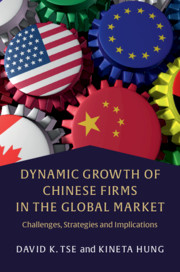Book contents
- Dynamic Growth of Chinese Firms in the Global Market
- Dynamic Growth of Chinese Firms in the Global Market
- Copyright page
- Contents
- Figures
- Tables
- 1 Introduction
- 2 China’s Economic Rise and Global Footprints of Chinese Firms
- 3 Globalisation of Chinese Firms Using Existing Paradigms
- 4 Globalisation of Chinese Firms Using New Paradigms
- 5 Challenges and Failures
- 6 Product Images and Market Acceptance of Chinese-Made Products
- 7 Corporate Social Responsibility
- 8 Managing National Image
- 9 China’s Technological Competence, Trade Relations, and Economic Co-operation
- 10 Holistic Conclusion through a Futuristic Lens
- Index
- References
8 - Managing National Image
Published online by Cambridge University Press: 05 February 2020
- Dynamic Growth of Chinese Firms in the Global Market
- Dynamic Growth of Chinese Firms in the Global Market
- Copyright page
- Contents
- Figures
- Tables
- 1 Introduction
- 2 China’s Economic Rise and Global Footprints of Chinese Firms
- 3 Globalisation of Chinese Firms Using Existing Paradigms
- 4 Globalisation of Chinese Firms Using New Paradigms
- 5 Challenges and Failures
- 6 Product Images and Market Acceptance of Chinese-Made Products
- 7 Corporate Social Responsibility
- 8 Managing National Image
- 9 China’s Technological Competence, Trade Relations, and Economic Co-operation
- 10 Holistic Conclusion through a Futuristic Lens
- Index
- References
Summary
As an economic power, China has become increasingly preoccupied with its image around the world. According to BBC-GlobeScan, China enjoys a neutral to positive national image over the past 12 years, driven by the generally positive perception of the country’s economy. Interestingly, there is a strong divide between perception by developed and developing nations, with the former giving China a much lower rating than the latter. The USA in particular gives a consistently low rating, while sub-Saharan African countries give a consistently high rating. The chapter then reports two ad campaigns carried out by the Chinese government to promote the national image, especially in the USA. Results of public surveys show that, while there is some positive outcome, the public do not like the hard-sell approach. It is suggested that, in the future, national image campaigns should take a softer approach and be carried out by non-governmental organisations or private firms to reduce governmental involvement.
Keywords
- Type
- Chapter
- Information
- Dynamic Growth of Chinese Firms in the Global MarketChallenges, Strategies and Implications, pp. 146 - 168Publisher: Cambridge University PressPrint publication year: 2020

